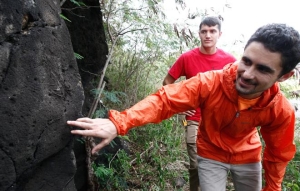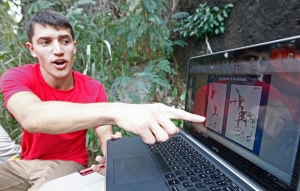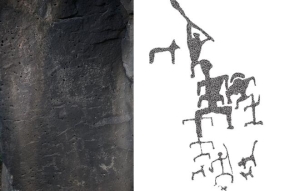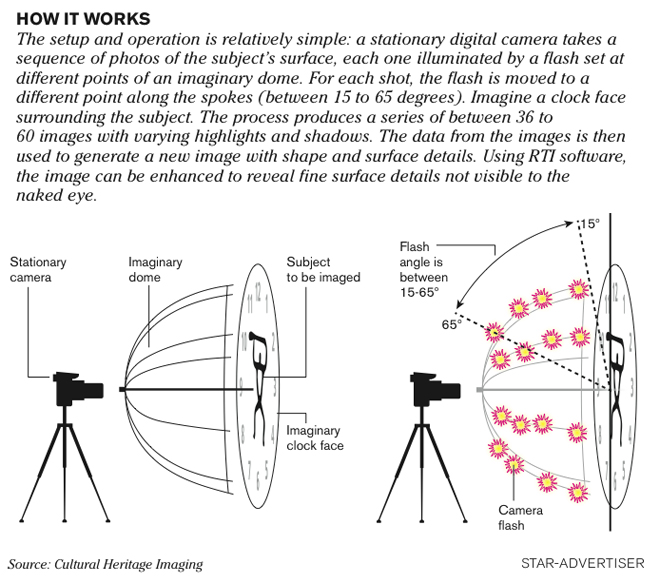Preservation in the News: Imaging technology allows for a clearer image and a way to monitor changes for Hawaii petroglyphs, many of which are located at sites at risk due to volcanic activity.
*********
Petroglyphs in fine detail
Imaging technology new to Hawaii brings out details of ancient carvings at an Army base
By Nina Wu
Honolulu Star , May 24, 2015

Photo credit: Jamm Aquino / jaquino@staradvertiser.com Torie Robinson, right, a cultural resources technician with the Research Corporation of the University of Hawaii, pointed to an anthropomorphic figure on a basalt rock face in January at Fort Shafter in Kalihi. At left is cultural resources specialist Anthony Casciano.
To the naked eye, the faint carvings at Fort Shafter appear to include a human figure holding a canoe paddle over two other figures. The panel is one of more than seven Hawaiian petroglyph features archaeologists discovered 15 years ago on a rock face atop a small, brush-covered hillside known as Kahauiki Stream at U.S. Army Pacific headquarters between Kalihi and Moanalua valleys.
With the help of a cutting-edge technology new to Hawaii — reflectance transformation imaging, or RTI — archaeologists recently discovered the panel has quite a few more human figures, or anthropomorphs, along with several dog figures.
The artistic style is consistent with petroglyphs dating to the pre-contact era (before 1778), according to U.S. Army Cultural Resources Program archaeologist Alton Exzabe. Before RTI was employed, he said, the petroglyphs were documented using regular photography, scaled drawings and hand sketches.
“The sketches didn’t seem to show everything we were seeing,” Exzabe said. “RTI allows us to get a more precise, as well as clearer, image, and a way to monitor changes more accurately.”
Exzabe’s colleagues, Anthony Casciano and Torie Robinson, both with the Research Corporation of the University of Hawaii, which works with the Army, had a hunch there was more to the panel there but couldn’t make out the ancient artwork. As the RTI software revealed additional figures to them on a laptop, the archaeologists were able to confirm it and better identify details such the figures’ curved arms and running legs — and they were able to do it without potentially damaging the petroglyphs.
The application of RTI technology to study petroglyphs is an exciting one, according to Carla Schroer, founder and director of Cultural Heritage Imaging, a San Francisco nonprofit that helped develop the interactive RTI software and other digital-imaging technologies used to preserve cultural and art treasures.

Photo: Jamm Aquino / jaquino@staradvertiser.com Archaeologists are using reflectance transformation imaging to detect fine surface details of petroglyphs with as little physical contact as possible. At left, Anthony Casciano points out the additional figures detectable on a petroglyph panel at Fort Shafter.
“We know many of the sites are at risk because of volcanic activity,” she said. “Documentation of sites at risk could help us preserve them for future generations.”
Reflectance transformation imaging has been used by conservators at the Fine Arts Museums of San Francisco and by archaeologists documenting rock art in the Coa Valley of Portugal. Other applications include examining ancient coins and forensic investigations.
The technology was invented by Tom Malzbender and Dan Gelb, research scientists at Hewlett-Packard Labs. The setup and operation is relatively simple: a stationary digital camera takes a sequence of photos of the subject’s surface, each one illuminated by a flash set at different points of an imaginary dome and all from the same distance to the subject. The process produces a series of up to 60 images with varying highlights and shadows.
The data is then used to calculate a new image with shape and surface details, which can be enhanced and examined on a laptop screen using RTI software.
Exzabe said the cost is relatively minimal — about $3,500 for a digital camera, two tripods, a laptop, camera flash and filters — for excellent results in return.
It’s straightforward enough that people familiar with photography and computers could use RTI on their own, with instruction. Cultural Heritage Imaging offers free downloads of its RTIBuilder and RTIViewer software along with user guides and demonstration videos.
Petroglyphs are found at more than 100 sites throughout the Hawaiian Islands, most frequently on boulders, cliff faces, cave walls and sandstone beach shelves. Rubbings and chalking were common methods of recording petroglyphs but are no longer condoned because they can wear down the carvings.

Jamm Aquino / jaquino@staradvertiser.com The photo, left, shows the panel of petroglyphs visible to the naked eye as captured by regular digital photography. The illustration, courtesy Oahu Army Cultural Resources Program, at right, demonstrated the additional human figures and dogs in the panel of petroglyphs captured by RTI technology.
Kelley Uyeoka, executive director of Huliauapa‘a on Hawaii island, first became aware of RTI at a presentation by Oahu Army Cultural Resources Program at a Society for Hawaiian Archaeology conference last October in Hilo. Huliauapa‘a is a nonprofit group that offers mentorship and training programs to encourage Native Hawaiians to enter the field of cultural resources management, in partnership with the University of Hawaii at Hilo’s Anthropology Department.
“It’s kind of a new technology for us,” she said. “What we really love about RTI is that it’s nondestructive. We’re interested in how we can utilize technology but in ways that don’t harm our artifacts.”
As development spreads across the island, many petroglyph sites are under threat, Uyeoka said. Huliauapa‘a is hoping to receive a grant from the Institute of Museum and Library Services to offer RTI training to its members.
So far the Army has used RTI to record petroglyphs at six of approximately 30 archaeological sites on its bases in Hawaii and will continue to document them. As for the interpretation of the petroglyphs at Fort Shafter, they remain a riddle.
“Petroglyphs likely had many different functions: spiritual, cultural and practical,” Exzabe said. “It is difficult to give an exact interpretation because we simply do not know for sure what the artists who created them were thinking.”
The images at Kahauiki Stream might have been used to tell a story, point the way or mark an occasion, he said. Whatever their purpose, documenting them and creating a database of the petroglyphs is important work.
“I see them as being rare and unique,” he said. “It is a glimpse in time. In the past, someone left their mark for a reason.”


